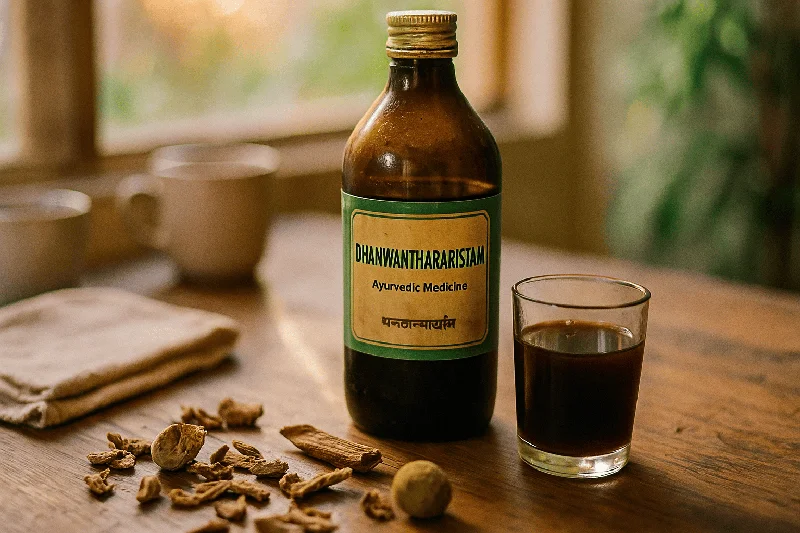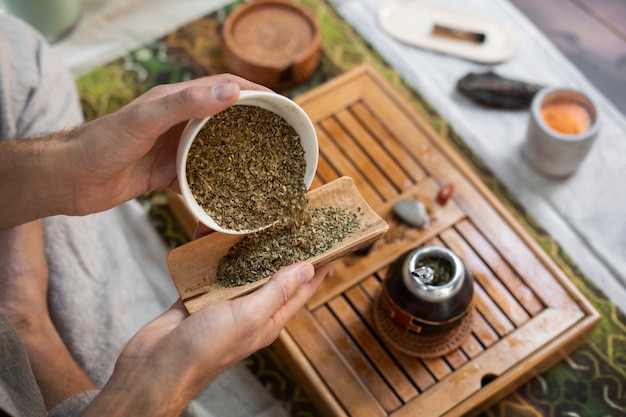आयुर्वेदिक डॉक्टर से प्रश्न पूछें और निःशुल्क या भुगतान मोड में अपनी चिंता की समस्या पर ऑनलाइन परामर्श प्राप्त करें। 2,000 से अधिक अनुभवी डॉक्टर हमारी साइट पर काम करते हैं और आपके प्रश्नों का इंतजार करते हैं और उपयोगकर्ताओं को उनकी स्वास्थ्य समस्याओं को हल करने में प्रतिदिन मदद करते हैं।
अभी हमारे स्टोर में खरीदें
Dhanwanthararishtam: An Ayurvedic Elixir Explained

Imagine a centuries-old herbal tonic that continues to garner attention both in traditional Ayurvedic practice and modern research circles. Dhanwanthararishtam, a time-honored remedy from the ancient system of Indian medicine, claims to offer benefits ranging from digestive support to postpartum care. But how much of this is folklore, and how much is grounded in science? Recent studies in ethnopharmacology and holistic medicine provide new insights that help bridge this gap. In this article, we will delve into the origins, composition, and potential health advantages of Dhanwanthararishtam, drawing from reputable sources such as peer-reviewed journals, authoritative medical institutions, and expert guidelines. Whether you are a healthcare professional seeking practical tips or a curious reader exploring alternative remedies, our goal is to present a balanced, evidence-based perspective that you can trust.
Table of Contents
- What Is Dhanwanthararishtam?
- Historical Significance and Traditional Uses
- Key Ingredients and Their Properties
- Scientific Evidence and Current Research
- How Dhanwanthararishtam Is Made
- Potential Benefits in Modern Healthcare
- Recommended Dosage and Usage Tips
- Safety Considerations and Side Effects
- Frequently Asked Questions (FAQ)
- Summary and Call to Action
1. What Is Dhanwanthararishtam?
Dhanwanthararishtam is an Ayurvedic formulation traditionally used to support overall health, digestive function, and postnatal recovery. Ayurveda, an ancient Indian system of medicine, conceptualizes health through a balance of three fundamental energies: Vata, Pitta, and Kapha. Dhanwanthararishtam is often prescribed to help restore equilibrium in these energies, focusing particularly on bolstering the digestive system and aiding the body’s natural healing processes. While it has a history steeped in tradition, modern scientific inquiry has begun to shed light on its specific components and potential modes of action. This herbal tonic is usually available in liquid form and is prepared using a natural fermentation process.
2. Historical Significance and Traditional Uses
Roots in Classical Ayurvedic Texts
Dhanwanthararishtam owes its name and some of its therapeutic claims to Dhanwantari, the Hindu god of medicine. Several classical Ayurvedic texts, including the Ashtanga Hridaya and Bhaishajya Ratnavali, mention formulations akin to Dhanwanthararishtam for a variety of ailments. Ayurvedic practitioners have historically prescribed it for:
- Postnatal Care: Supporting women’s recovery after childbirth.
- Gastrointestinal Issues: Alleviating indigestion, gas, and bloating.
- Joint and Muscle Ailments: Managing mild aches and pains.
- Convalescence: Assisting recovery during prolonged illnesses.
Cultural Relevance
In many parts of India, Dhanwanthararishtam remains a staple for postpartum women. It is also recommended for older adults to maintain joint health, although clinical guidance varies depending on individual constitutions and co-existing conditions.
3. Key Ingredients and Their Properties
Dhanwanthararishtam is a polyherbal concoction—meaning it contains multiple herbal ingredients, each contributing to the final therapeutic effect. Here are some core components often cited in traditional formulations:
-
Dashamoola (Group of Ten Roots)
- A collective of ten roots, including Bilva, Agnimantha, and Gokshura, often employed to support nervous system function and help reduce inflammation.
-
Trikatu (Blend of Three Spices: Ginger, Black Pepper, Long Pepper)
- Known for stimulating digestion and enhancing metabolic function.
-
Jeeraka (Cumin)
- Typically used to aid digestion, possibly acting as a carminative agent that reduces gas and bloating.
-
Haritaki (Terminalia chebula)
- Often referred to as the “king of medicines” in Ayurveda, known for its digestive and antioxidant properties.
-
Mustha (Cyperus rotundus)
- Traditionally used to soothe gastrointestinal discomfort and help regulate menstrual cycles.
These herbs undergo fermentation with natural sugars (like jaggery) and water, which facilitates the extraction of bioactive compounds.
4. Scientific Evidence and Current Research
Evolving Scientific Perspective
While historical use underscores Dhanwanthararishtam’s significance, modern interest in this formulation has been growing. Studies focusing on herbal medicines are increasingly common in journals such as the Journal of Ethnopharmacology and Evidence-Based Complementary and Alternative Medicine (eCAM).
-
Digestive Health
- A 2020 study in the Indian Journal of Traditional Knowledge explored how polyherbal formulations containing Trikatu improved gut motility and reduced symptoms of indigestion. Although the study did not focus solely on Dhanwanthararishtam, the individual ingredients are known to influence digestive physiology.
-
Anti-Inflammatory Properties
- Compounds found in Dashamoola have demonstrated anti-inflammatory and analgesic effects in animal models (Journal of Ethnopharmacology, 2019). This could partly explain Dhanwanthararishtam’s traditional usage in musculoskeletal discomfort.
-
Antioxidant Activity
- Preliminary laboratory research suggests that some ingredients in Dhanwanthararishtam, such as Haritaki, exhibit antioxidant properties by scavenging free radicals. However, large-scale human trials are needed for more conclusive data.
Limitations and Future Directions
- Lack of Large-Scale Clinical Trials: Current data mostly stem from small-scale clinical or animal studies.
- Variability in Formulations: Differences in manufacturing practices and ingredient quality can influence outcomes.
- Need for Standardization: Experts agree on the necessity of standardizing active compounds for consistent results.
Overall, while initial findings are promising, more robust research is needed to validate Dhanwanthararishtam’s efficacy and safety profile conclusively.
5. How Dhanwanthararishtam Is Made
Fermentation Process
- Primary Ingredients: Herbs like Dashamoola, spices such as ginger and pepper, jaggery, and purified water.
- Preparation: The herbs are cleaned, crushed, or powdered to facilitate extraction.
- Mixing: Herbs and jaggery are dissolved in water in a clean vessel.
- Fermentation: The mixture is allowed to ferment naturally for 15–30 days in a controlled environment, usually in earthen or stainless-steel containers.
- Filtration and Storage: Once fermented, the liquid is filtered and stored in airtight bottles.
Quality Control
Modern Ayurvedic manufacturers may use standardized procedures to ensure microbial safety and consistent concentration of bioactive compounds. Make sure to purchase from reputable brands that comply with Good Manufacturing Practices (GMP) guidelines.
6. Potential Benefits in Modern Healthcare
Based on both traditional usage and emerging studies, the following areas have garnered interest:
- Digestive Support: Ingredients like Trikatu and cumin can stimulate digestive enzymes, reduce bloating, and enhance nutrient absorption.
- Postnatal Recovery: Traditionally prescribed to help restore energy and balance hormones after childbirth, though scientific data are limited.
- Joint and Muscle Health: Anti-inflammatory herbs may support joint comfort and muscle recovery, especially in minor aches and pains.
- Antioxidant Support: Free radical scavenging properties could offer general health benefits and immune system support.
7. Recommended Dosage and Usage Tips
Typical Dosage
- Adults: 15–30 ml once or twice daily, usually after meals.
- Children: Generally lower doses based on age and weight, often under direct supervision of an Ayurvedic practitioner.
Practical Tips
- Combine with Warm Water: Some experts recommend diluting Dhanwanthararishtam in a small amount of warm water to make it more palatable and aid absorption.
- Timing: Taking it post-meal can help reduce potential gastric irritation.
- Professional Consultation: Always consult a healthcare provider for personalized guidance, especially if you have pre-existing conditions or are on medication.
8. Safety Considerations and Side Effects
Known Side Effects
- Mild Gastrointestinal Discomfort: Some users report a warming sensation or mild acid reflux.
- Allergic Reactions: Rare, but possible if individuals have sensitivities to specific herbs.
Who Should Be Cautious?
- Pregnant and Nursing Women: Despite traditional uses, modern guidelines often recommend caution or consultation with a qualified practitioner.
- Individuals with Chronic Conditions: Those with liver, kidney, or heart conditions should seek medical advice before starting any new supplement.
- Medication Interactions: Certain herbs could potentially interact with prescription drugs, particularly blood thinners or diabetic medications.
Disclaimer: This article provides general information. Consult a qualified medical professional for personalized health advice.
9. Frequently Asked Questions (FAQ)
-
Is Dhanwanthararishtam safe for long-term use?
- While traditionally considered safe for extended use, long-term intake should be supervised by a qualified healthcare provider, especially if you have chronic health issues.
-
Can it replace conventional treatments?
- Dhanwanthararishtam is considered a complementary therapy in Ayurveda. It is not intended to replace allopathic medicines or treatments advised by your physician.
-
Where can I buy authentic Dhanwanthararishtam?
- Look for reputable Ayurvedic pharmacies or brands that follow GMP standards. Always check labels and certifications.
-
Is there scientific proof of its effectiveness?
- Preliminary research suggests potential benefits, but large-scale human trials are limited. Consult reputable medical journals or databases like PubMed for ongoing studies.
-
Can children take Dhanwanthararishtam?
- Yes, but only in prescribed doses and under the guidance of an Ayurvedic practitioner, given children’s differing physiology.
10. Summary and Call to Action
Dhanwanthararishtam stands at the intersection of rich Ayurvedic heritage and evolving modern research. Rooted in centuries of clinical use, this herbal formulation draws interest for its potential to aid digestion, support postpartum recovery, and offer mild anti-inflammatory and antioxidant benefits. Yet, as science continues to unravel the complexities of its bioactive compounds, it is essential to rely on reputable sources and professional guidance.
If you found this article informative, please share it with your friends, family, and colleagues who might be interested in alternative healthcare solutions. Feel free to leave a comment below with your experiences, questions, or insights related to Dhanwanthararishtam. To stay updated on the latest developments in traditional and modern healthcare, subscribe to our newsletter for regular, evidence-based articles.
References and Further Reading
- Ashtanga Hridaya and Bhaishajya Ratnavali (Classical Ayurvedic Texts)
- Journal of Ethnopharmacology (2019, 2021)
- Indian Journal of Traditional Knowledge (2020)
- Evidence-Based Complementary and Alternative Medicine (Various Issues)
- WHO Guidelines on Good Manufacturing Practices (GMP) for Herbal Medicines
- PubMed Central () – for peer-reviewed medical studies
Disclaimer:
The information provided here is intended for general knowledge and is not a substitute for professional medical advice. Consult a qualified healthcare professional before starting any new treatment, especially if you have underlying health conditions or are on medication.
By integrating current research, traditional Ayurvedic wisdom, and a balanced perspective, this guide aims to help you make informed decisions about Dhanwanthararishtam. Always exercise caution and consult healthcare professionals for personalized advice.
यह लेख वर्तमान योग्य विशेषज्ञों द्वारा जाँचा गया है Dr. Harsha Joy और इसे साइट के उपयोगकर्ताओं के लिए सूचना का एक विश्वसनीय स्रोत माना जा सकता है।




